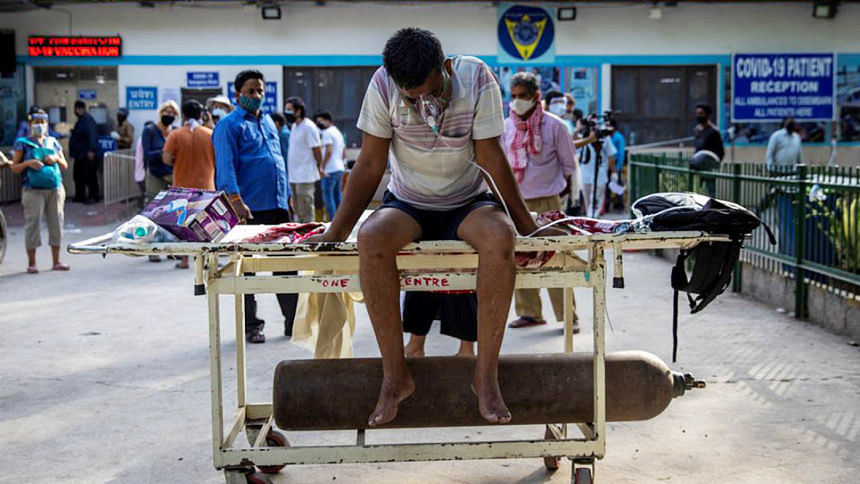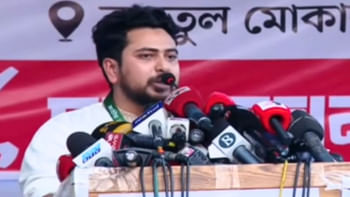Covid ‘tsunami’ hammers India

India's daily coronavirus death toll set a new record yesterday as the government battled to get oxygen to hospitals overwhelmed by the hundreds of thousands of new daily cases.
Twenty patients died in one night at one New Delhi hospital suffering from oxygen shortages, medical officials said. A Delhi court said that the new pandemic wave had become "a tsunami".
Queues of Covid-19 patients and their fearful relatives were growing outside hospitals in major cities across India, the world's new pandemic hotspot, which has now reported nearly one million new cases in three days.
Another 2,624 deaths were reported in 24 hours, taking the official toll to nearly 190,000 since the pandemic started.
More than 340,000 new cases were also reported, taking India's total to 16.5 million, second only to the United States.
But many experts are predicting the current wave will not peak for at least three weeks and that the real death toll and case count are much higher.
Germany and Kuwait yesterday followed the United Arab Emirates, Britain and New Zealand in restricting travel from the country.
Stung by criticism of its lack of preparation ahead of the wave of infections, the central government has organised special trains to get oxygen supplies to the worst-hit cities.
The Indian air force was also being used to transport oxygen tankers and other supplies around the country and to bring oxygen equipment from Singapore.
The government has also pressed industrialists to increase production of oxygen and life-saving drugs.
It also exempted import of Covid vaccines from basic customs duty with immediate effect for a period of three months in a bid to keep low the prices of overseas jabs, reported our New Delhi correspondent.
Import of oxygen and oxygen-related equipment also received full exemption from basic customs duties for three months with immediate effect to augment their availability in domestic markets.
The decisions were taken at a high-level meeting chaired by Prime Minister Narendra Modi in New Delhi.
One 'oxygen express' carrying 30,000 litres for hospitals arrived in Lucknow, Uttar Pradesh state, where armed guards were waiting to escort trucks that would carry the oxygen to hospitals.
Lucknow has been one of the worst-hit cities, with hospitals and crematoriums inundated with patients and bodies. Officials said the liquid oxygen would only be enough for half a day's needs.
Uttar Pradesh, a state of 200 million people, has imposed a weekend lockdown in a bid to curb the spread.
Many patients are dying outside hospitals in New Delhi because of the lack of beds and oxygen. Television showed families tending to the sick in hospital corridors and streets as they waited for medical attention.
Twenty patients at the Jaipur Golden Hospital in the capital died during the night as it suffered oxygen shortages, the hospital's director told Indian media.
He said that at one stage yesterday morning, the reserve was down to 30 minutes and pressure had been reduced for the 200 coronavirus patients, most of whom were on emergency oxygen.
Max Healthcare, which runs a network of hospitals in north India, tweeted that it had less than two hours of oxygen left while Fortis Healthcare, another big chain, said it was suspending new admissions in Delhi.
"We are running on backup, waiting for supplies since morning," Fortis said.
One charity has set up an overflow crematorium in a car park, with makeshift funeral pyres built to deal with the mounting deaths.
Hospitals in Delhi have gone to the city's high court this week seeking it to order the state and federal governments to make emergency arrangements for medical supplies, mainly oxygen.
"It's a tsunami. How are we trying to build capacity?" the Delhi high court asked the state and federal governments in response to this plea.
"We know how people react, let's not have a law and order situation," the court said in its direction to the authorities.
The federal government had declared it had beaten back the coronavirus in February.
Health experts said India became complacent in the winter, when new cases were running at about 10,000 a day and seemed to be under control. Authorities lifted restrictions, allowing for the resumption of big gatherings.
Others said that it could also be a more dangerous variant of the virus coursing through India. It is the world's second most populous country and people live in close proximity, often six to a room.
"While complacency in adhering to masks and physical distancing might have played a role, it seems increasingly likely that this second wave has been fuelled by a much more virulent strain," wrote Vikram Patel, Professor of Global Health at Harvard Medical School, in the Indian Express.
Meanwhile, the government of the eastern Indian state of Odisha has sealed its land border with adjacent West Bengal where the reported presence of a triple mutant variant of Covid-19 has caused concerns.
The triple mutant strain of the virus is apprehended by doctors as spreading faster than other variants.
Experts say the only way India can turn the tide is to ramp up vaccinations and impose strict lockdowns in the so-called red zones of high infection. It has opened up the immunisation programme to all adults but faces a shortage.
India is currently using the AstraZeneca shot and homegrown Covaxin. It has also approved Russia's Sputnik V and has urged Pfizer Moderna and Johnson and Johnson to provide it with vaccines.

 For all latest news, follow The Daily Star's Google News channel.
For all latest news, follow The Daily Star's Google News channel. 



Comments